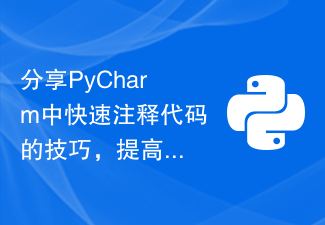php editor Banana has carefully compiled a "PHPDoc Expert Guide: Mastering the Secrets of Code Documentation", aiming to help PHP developers master the techniques and secrets of code documentation. This guide covers the basic knowledge, markup specifications, best practices, etc. of PHPDoc. It is designed to help developers write clear and standardized code documents and improve code readability and maintainability. By studying this guide, developers can better understand how to use PHPDoc and improve code quality and team collaboration efficiency.
PHPDoc is a standardized format for adding documentation comments in php code. These annotations provide detailed metadata about classes, methods, parameters, and properties, thereby improving code readability and maintainability.
Basic syntax
PHPDoc comments begin with double slashes (//), followed by the comment text. The text begins with a tag (such as @param), followed by a space and the tag value. For example:
/**
* 求两个数的总和
*
* @param int $num1 第一个数字
* @param int $num2 第二个数字
* @return int 总和
*/
function sum(int $num1, int $num2): int
{
return $num1 + $num2;
}
Label
PHPDoc supports various tags for specifying different types of metadata. The most commonly used tags include:
-
@param: Specify the parameters of the method or function. -
@return: Specify the return value of the method or function. -
@var: Specifies the type of attribute. -
@throws: Specify exceptions that may be thrown by a method or function. -
@see: Links to other documents or resources.
Type annotations
Type annotations allow you to specify the data types of variables, parameters, and return values. This can help IDEs and code analysis tools identify and prevent potential type errors. For example:
/**
* 返回当前时间戳
*
* @return string 时间戳
*/
function getTimestamp(): string
{
return time();
}
Block comments
Block comments provide more detailed documentation describing the purpose, methods, and properties of a class. They end with /** Start with */. For example:
/**
* 管理用户账户
*
* 此类提供用于创建、读取、更新和删除用户账户的方法。
*/
class UserAccountManager
{
// ...
}
Documentation Generator
PHPDoc comments can be converted into readable documentation using a documentation generator such as phpDocumentor. These documents can be generated in various formats such as html, markdown, etc.
Best Practices
Following PHPDoc best practices can improve the quality of code documentation:
- Add annotations for all public methods and properties.
- Use descriptive names and clear descriptions.
- Use appropriate tags and type annotations.
- Keep comments in sync with code.
benefit
PHPDoc code documentation provides many benefits, including:
- Improve code readability: Comments make the code easier to understand and maintain.
- Reduce debugging time: Clear documentation reduces the time needed to debug erroneous code.
- Improve code reusability: Good documentation makes it easier to reuse code.
- Promote code collaboration: Comments help communication and collaboration between developers .
in conclusion
PHPDoc is a powerful tool that can significantly improve the documentation level of PHP code. By following best practices and taking advantage of its rich tags and features, you can create clear, readable documentation that improves code maintainability, facilitates collaboration, and prevents errors.
The above is the detailed content of PHPDoc Expert Guide: Master the Secrets of Code Documentation. For more information, please follow other related articles on the PHP Chinese website!
 便捷使用PyCharm快捷键实现多行注释Jan 27, 2024 am 08:02 AM
便捷使用PyCharm快捷键实现多行注释Jan 27, 2024 am 08:02 AMPyCharm多行注释快捷键:让代码注释更加便捷,需要具体代码示例在日常的编程工作中,代码注释是非常重要的一部分。它不仅可以提高代码的可读性和可维护性,还能帮助其他开发人员理解代码的意图和设计思路。然而,手动添加代码注释往往是一项耗时而繁琐的工作。为了让我们的代码注释更加高效,PyCharm提供了多行注释的快捷键。在PyCharm中,我们可以使用Ctrl+/
 如何优化Java代码的可维护性:经验与建议Nov 22, 2023 pm 05:18 PM
如何优化Java代码的可维护性:经验与建议Nov 22, 2023 pm 05:18 PM如何优化Java代码的可维护性:经验与建议在软件开发过程中,编写具有良好可维护性的代码是至关重要的。可维护性意味着代码能够被轻松理解、修改和扩展,而不会引发意外的问题或额外的工作量。对于Java开发者来说,如何优化代码的可维护性是一个重要课题。本文将分享一些经验和建议,帮助Java开发者提升其代码的可维护性。遵循规范的命名规则规范的命名规则能够使代码更易读,
 PHP 代码文档化之王:PHPDoc 的进阶指南Mar 02, 2024 am 08:43 AM
PHP 代码文档化之王:PHPDoc 的进阶指南Mar 02, 2024 am 08:43 AM引言:PHPDoc是一种用于php代码的注释标准,可生成易于理解且信息丰富的文档。通过使用特定的注释标签,PHPDoc允许开发人员提供有关函数、类、方法和其他代码元素的重要详细信息。这篇进阶指南将深入探讨PHPDoc,展示其功能并提供有效的文档化策略。语法和标签:PHPDoc注释以双斜杠(//)或多行注释(/**/)开头。以下是一些常见的注释标签:@param:定义函数或方法的参数。@return:指定函数或方法的返回值。@throws:说明函数或方法可能引发的异常。@var:定义类的属性或实例
 go语言中怎么注释多行Jan 05, 2023 am 10:59 AM
go语言中怎么注释多行Jan 05, 2023 am 10:59 AM在go语言中,可以使用多行注释符“/**/”来注释多行代码。多行注释(简称块注释),以“/*”开头,并以“*/”结尾,且不可以嵌套使用,语法“/*注释内容...*/”;多行注释一般用于包的文档描述或注释成块的代码片段。
 点亮代码之路:使用 PHPDoc 照亮代码库Mar 01, 2024 pm 03:07 PM
点亮代码之路:使用 PHPDoc 照亮代码库Mar 01, 2024 pm 03:07 PM作为PHP开发人员,编写清晰、可维护的代码至关重要。代码注释是实现这一目标的关键,而phpDoc作为PHP的文档生成标准,为我们提供了强大而标准化的注释工具。PHPDoc基础PHPDoc注释以/*和/标记包围,并遵循特定的语法:/***函数或类的描述**@param类型$参数名描述*@return类型描述*/函数注释函数注释提供了以下信息:函数描述参数类型和描述返回值类型和描述例如:/***计算两个数的和**@paramint$a第一个数*@paramint$b第二个数*@returnint和*
 一文详解golang中的注释Mar 21, 2023 pm 07:38 PM
一文详解golang中的注释Mar 21, 2023 pm 07:38 PMGolang是一种编程语言,它有着比较高的代码可读性和简洁性。然而,在编写代码时,总有些地方需要添加注释来帮助解释某些细节或者增加代码的可读性。在这篇文章中,我们将介绍一些关于Golang注释的内容。
 分享PyCharm中快速注释代码的技巧,提高工作效率Jan 04, 2024 pm 12:02 PM
分享PyCharm中快速注释代码的技巧,提高工作效率Jan 04, 2024 pm 12:02 PM效率提升!PyCharm中快速注释代码的方法分享在日常的软件开发工作中,我们经常需要注释掉一部分代码进行调试或者调整。如果手动逐行添加注释,这无疑会增加我们的工作量和耗费时间。而PyCharm作为一款强大的Python集成开发环境,提供了快速注释代码的功能,大大提升了我们的开发效率。本文将分享一些在PyCharm中快速注释代码的方法,并提供具体的代码示例。单
 php语言支持几种注释风格Feb 15, 2022 pm 02:05 PM
php语言支持几种注释风格Feb 15, 2022 pm 02:05 PMphp语言支持3种注释风格:1、C++风格,使用“//”符号,语法“//注释内容”;2、C语言风格,使用“/* */”符号,语法“/* 注释内容 */”;3、Shell风格(Perl风格),使用“#”符号,语法“#注释内容”。


Hot AI Tools

Undresser.AI Undress
AI-powered app for creating realistic nude photos

AI Clothes Remover
Online AI tool for removing clothes from photos.

Undress AI Tool
Undress images for free

Clothoff.io
AI clothes remover

AI Hentai Generator
Generate AI Hentai for free.

Hot Article

Hot Tools

SublimeText3 Linux new version
SublimeText3 Linux latest version

WebStorm Mac version
Useful JavaScript development tools

Dreamweaver CS6
Visual web development tools

SAP NetWeaver Server Adapter for Eclipse
Integrate Eclipse with SAP NetWeaver application server.

SublimeText3 Chinese version
Chinese version, very easy to use






